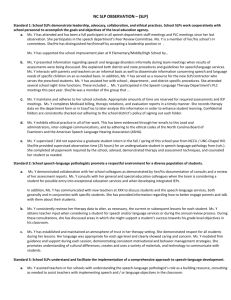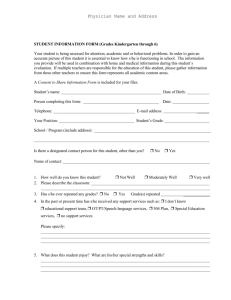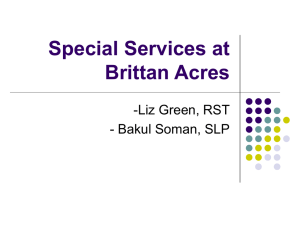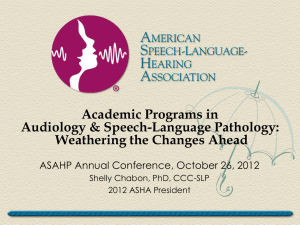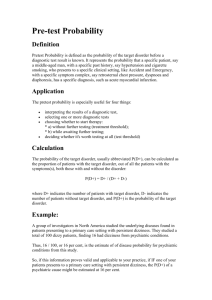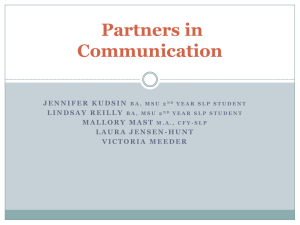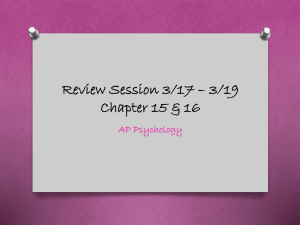Frequently Asked Questions About Speech And Language
advertisement
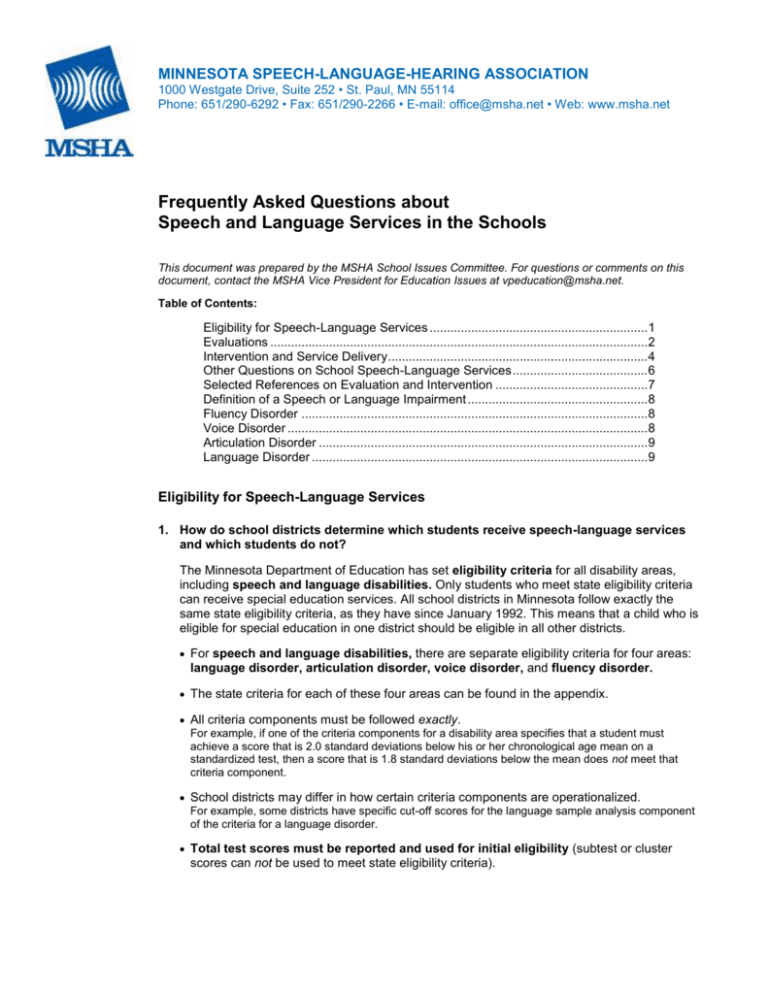
MINNESOTA SPEECH-LANGUAGE-HEARING ASSOCIATION 1000 Westgate Drive, Suite 252 • St. Paul, MN 55114 Phone: 651/290-6292 • Fax: 651/290-2266 • E-mail: office@msha.net • Web: www.msha.net Frequently Asked Questions about Speech and Language Services in the Schools This document was prepared by the MSHA School Issues Committee. For questions or comments on this document, contact the MSHA Vice President for Education Issues at vpeducation@msha.net. Table of Contents: Eligibility for Speech-Language Services ............................................................... 1 Evaluations ............................................................................................................. 2 Intervention and Service Delivery ........................................................................... 4 Other Questions on School Speech-Language Services ....................................... 6 Selected References on Evaluation and Intervention ............................................ 7 Definition of a Speech or Language Impairment .................................................... 8 Fluency Disorder .................................................................................................... 8 Voice Disorder ........................................................................................................ 8 Articulation Disorder ............................................................................................... 9 Language Disorder ................................................................................................. 9 Eligibility for Speech-Language Services 1. How do school districts determine which students receive speech-language services and which students do not? The Minnesota Department of Education has set eligibility criteria for all disability areas, including speech and language disabilities. Only students who meet state eligibility criteria can receive special education services. All school districts in Minnesota follow exactly the same state eligibility criteria, as they have since January 1992. This means that a child who is eligible for special education in one district should be eligible in all other districts. For speech and language disabilities, there are separate eligibility criteria for four areas: language disorder, articulation disorder, voice disorder, and fluency disorder. The state criteria for each of these four areas can be found in the appendix. All criteria components must be followed exactly. For example, if one of the criteria components for a disability area specifies that a student must achieve a score that is 2.0 standard deviations below his or her chronological age mean on a standardized test, then a score that is 1.8 standard deviations below the mean does not meet that criteria component. School districts may differ in how certain criteria components are operationalized. For example, some districts have specific cut-off scores for the language sample analysis component of the criteria for a language disorder. Total test scores must be reported and used for initial eligibility (subtest or cluster scores can not be used to meet state eligibility criteria). Frequently Asked Questions about Speech and Language Services in the Schools Determining eligibility for students who are English Language Learners (ELL) is complicated because eligibility for these students must be based on the identification of a communication disorder in the student’s native language, as well as English. Therefore, different evaluation procedures are required and interpreters must be used. In addition, it is inappropriate to use or report standard scores from norm referenced tests for these students. See Question #5 for further information on specific ELL issues in evaluation and intervention. 2. Can a student who does not meet state eligibility criteria for a disability ever receive special education services, including services for speech-language disabilities? Under certain extenuating circumstances, a student’s evaluation team (which includes parents) may determine that a student is eligible for special education services even though the student does not meet the relevant eligibility criteria. In these cases, a team override is used. The team override process requires additional evaluation and documentation. The team must provide additional data that explains why the standards and procedures used with the majority of students resulted in invalid findings for this student. Evaluations 3. What is the process that schools use to evaluate a student for a suspected speech-language disability? The special education evaluation process is spelled out in a number of federal laws (i.e., Individuals with Disabilities Act, or IDEA) and state rules (i.e., Minnesota Department of Education). What are some requirements for evaluations in schools? Pre-referral Interventions: Regular education teachers must implement (and document results for) two pre-referral interventions for the behavior(s) of concern prior to a referral for special education evaluation. The requirement for documented pre-referral interventions applies to all areas of communication: language, articulation, voice and stuttering, as well as all other areas of special education. Results from pre-referral interventions are used to help determine if an evaluation is necessary. Evaluation planning meeting involving parents: An evaluation planning meeting must be held and parents must have input when the team reviews pre-referral and classroom performance data, discusses specific evaluation needs, and plans out a comprehensive evaluation. Evaluations for special education eligibility require the use of multiple data sources: Multiple evaluation tools and methods must be used to determine eligibility for special education services, including speech-language services. It is not appropriate to use only standardized or normreferenced tests. Instead, additional evaluation tools must be used in conjunction with standardized tests. These may include observations and behavioral samples, teacher/parent interviews, checklists, criterion referenced tests, and other informal evaluation procedures. For example, an initial evaluation for a language disorder must include the following components: – Parent information and/or concerns (for example, parent interview/checklists) – Teacher information and/or concerns (for example, teacher interview/checklists) – Review of existing evaluation data (file review, review of pre-referral intervention data, review of curriculum-based measurement data, prior testing, etc.) – At least two technically adequate, norm-referenced tests. Note: Total test scores (not subtest scores or cluster scores) must fall at least two standard deviations below the mean in order to meet state eligibility criteria. – Language and/or communication sample(s) – Systematic classroom observation(s) February 2004 page 2 of 9 Frequently Asked Questions about Speech and Language Services in the Schools – Other documented language procedures as needed (including criterion-referenced tests, checklists and other informal tasks) Timelines and Evaluation Summary Meeting: The school team has to complete the evaluation and report the results to the parent within 30 school days of the parent’s consent to the evaluation. The evaluation summary report must address all eligibility components for the specific speech-language disability category of concern (e.g., language, articulation, voice, stuttering). 4. What is the school district’s responsibility when they receive an evaluation for speechlanguage that has been done at an outside agency? The district has the responsibility to consider information from an outside evaluation, including recommendations for service. The student’s special education team may accept, in part or whole, or reject the information if it has data to dispute the findings. 5. What are some of the special issues related to speech-language evaluations and therapy for students who are English Language Learners (ELL)? Evaluations and Eligibility School districts are required to use unbiased evaluation tools, and to rule out the presence of cultural, linguistic, and socioeconomic (i.e., poverty) factors when evaluating students from diverse ethnic or cultural backgrounds for eligibility for speech-language services. For example: – School districts must use multiple evaluation tools and approaches including criterion-referenced and informal evaluations, – The use of standardized, norm-referenced tests (and the application of test norms) with ELL students is extremely problematic, and should be avoided. Issues include: Norms can only be applied to students in the test’s normative sample; ELL students are almost never included in normative samples. When standardized tests have not been normed on ELL students’ cultural/ethnic groups, computed or standard scores are likely to contain bias, and should not be reported nor used to determine special education eligibility. – School districts must access a member of the student’s cultural and language community to help interpret evaluation results, when possible. – School districts must consider the length of time the student has been in the United States, and the amount and consistency of formal education that the student has received. Testing must be done in the student’s native language to determine if a speech-language disorder exists in the student’s native language as well as English. An interpreter who speaks the student’s native language must be used during all parts of the evaluation, including student testing, collecting communication samples, and communicating with the student’s parents. ELL students are eligible for speech-language services in the schools only if a speech-language disorder can be demonstrated in the native language and in English. ELL students are not eligible for speech-language services if their communication problems are the result of learning English. Intervention School teams must take into account specific linguistic differences from the student’s native language. This means that teams must ensure that, for students who are eligible for service, IEP goals for speech and language focus on errors on sounds and language patterns that exist in the student’s native language. – For example, some languages from Southeast Asia do not mark verb tenses and therefore may not be present in the student’s language when learning to speak English. Lack of verb tenses in February 2004 page 3 of 9 Frequently Asked Questions about Speech and Language Services in the Schools this case would not necessarily indicate a language disability. Teachers of English as a Second Language (ESL) might choose to work on verb tenses as part of the student’s general education and ESL curriculum. 6. What other evaluation issues are relevant for speech-language pathologists (SLPs) that work in schools? Reporting test scores: The reporting of test scores in standard deviation units is required for eligibility decisions. It is acceptable to report percentile ranks and other standard scores in addition to standard deviation units. It is not acceptable to use or report age-equivalent scores (McCauley & Swisher, 1984). Total test scores (not subtest scores or cluster scores) must fall at least two standard deviations below the mean in order to meet state eligibility criteria for articulation and language disabilities. Make sure tests are technically adequate: It is the responsibility of the SLP to be sure that any and all tests used are valid and reliable for identifying communication disabilities. For example: – Test norms older than ten years are not technically adequate (Salvia & Ysseldyke, 1988). – Tests with samples of less than 100 students per age/grade interval are not technically adequate (Salvia & Ysseldyke, 1988). – The journals of the American Speech-Language-Hearing Association (ASHA) regularly publish research articles on this topic. For example, research on a number of commonly used tests (Test of Problem Solving: Bernhardt, 1990; Sakarakis-Doyle & Mallet, 1991; Peabody Picture Vocabulary Test - Revised: Washington & Craig, 1992) raises serious questions on their validity, reliability and/or bias when used with students from certain minority groups. – Single-word vocabulary tests, in particular, have been shown to have poor validity for identifying students with expressive or receptive language problems (Gray, Plante, Vance, & Henrichsen, 1999). Therapy objectives should not be determined solely from errors on standardized tests (McCauley & Swisher, 1984; Merrell & Plante, 1997). According to McCauley and Swisher (1984), “…the use of test items in planning therapy may often result in an impoverished and potentially inappropriate set of objectives. There is probably no circumstance in which norm-referenced test items can profitably be used for this purpose” (p. 344). Intervention and Service Delivery 7. What types of speech-language intervention are available in the schools? Speech-language intervention in schools, or educational models, may look different from intervention in outside agencies, or clinical models. There are a number of important reasons for this: First, federal and state laws require that special education services, including speech-language intervention, be provided first in the least restrictive environment or the LRE. For the majority of students, the LRE is either in the general education classroom or the special education classroom. Second, special education regulations require that a continuum of services be available to meet the needs of students. In other words, schools must have a variety of service options available including indirect service (or consultation) and direct service. The student’s Individual Education Plan (IEP) team decides which type of service can best meet the student’s needs at this point in time. It is expected that the type of service a student needs will change over time depending on the student’s level of performance and the educational environment the student is in. February 2004 page 4 of 9 Frequently Asked Questions about Speech and Language Services in the Schools Third, federal and state laws require that special education services, including speech-language intervention, be designed to ensure students can progress in the general education curriculum (e.g., language arts, math, social studies) and attempt to meet the same education standards that apply to all children. This has been interpreted to mean that students’ IEPs must be educationally relevant (social, academic, vocational); that is, IEP goals must be related to the student’s progress in the general education curriculum. Fourth, research has shown that the educational environment has some very powerful advantages for meeting the intervention needs of students with disabilities (Wilcox et. al., 1991). One advantage is the use of multiple intervention agents to work on a student’s individual goals and objectives. In addition to the SLP, multiple intervention agents include regular education and special education teachers, specialists in art, music and physical education, and teaching assistants. A second advantage of providing speech-language intervention in educational environments is that there are multiple opportunities throughout the school day for meeting student goals in the regular education classroom and throughout the curriculum. Here are a few of the types of speech-language intervention that can be used in educational environments to meet a student’s individual needs, goals, and objectives (Cirrin & Penner, 1995): Indirect intervention or consultation provided by the SLP to regular education and special education teachers. Combination of indirect and direct intervention. Direct intervention in the least restrictive environment (e.g., in the regular education and/or special education classroom). Direct intervention outside the least restrictive environment, as needed (or in combination with some classroom-based service). Team teaching by the SLP and teacher in the regular education and/or special education classroom. Language and/or communication lessons/curriculum to entire class by SLP Speech-language groups in regular education classroom. Curriculum-based intervention using materials adapted from the regular education classroom. Home program with parents, siblings, and/or peers for generalization and carry-over. At the annual IEP meeting for a student with a communication disability, the IEP team determines the appropriate intervention model and frequency of intervention given the least restrictive environment, the general education curriculum, the advantages of the educational environment and the continuum of service options listed above. 8. What is the school district’s responsibility when they receive recommendations from an outside agency for a student for a specific type or frequency of speech-language intervention? First, students need to meet state eligibility criteria to receive school speech-language services. Second, as with outside evaluations, the district has the responsibility to consider information from outside agencies, including recommendations for service. The IEP team may accept, in part or whole, or reject the information if it has data to dispute the findings. In general, the courts have established that the determination of the specific instructional methods and frequency of intervention are the prerogative of the school district (e.g., the student’s IEP team). February 2004 page 5 of 9 Frequently Asked Questions about Speech and Language Services in the Schools Other Questions on School Speech-Language Services 9. What rights do parents have if they disagree with the school district on special education issues for their child, including evaluation and intervention issues? Parents have many rights under federal and state laws and regulations. These rights are described in a brochure titled “Parent Rights” and available from the Minnesota Department of Education, or their own school district. In general, parents’ input is equal to, but no greater than, any other team member’s input. 10. What are the credentials of SLPs in schools? SLPs working in schools are licensed by the Minnesota Board of Teaching. Current licensure requirements include a master’s degree from a university accredited by the American SpeechLanguage-Hearing Association (ASHA) program or ASHA certification, as well as continuing education requirements to maintain licensure. Many SLPs in schools also choose to carry licenses from the Minnesota Department of Health. 11. Can parents obtain additional speech-language services for their child at outside agencies? Yes. For children who do not meet state eligibility criteria, some parents may choose to obtain speech-language services for their child at outside agencies at their own expense. Outside agencies typically do not have to follow federal or state special education rules or eligibility criteria. For children who have met criteria and who receive speech-language services in the schools, some parents may choose to obtain supplemental services for their child at outside agencies at their own expense. In these cases, SLPs in schools can help coordinate the student’s plan of care with SLPs in other settings. 12. How can SLPs in schools and outside agencies work together to serve students with communication disabilities and their families? Recommendations for speech-language service by outside agencies: SLPs in hospitals, medical settings, and private practice can become familiar with state eligibility criteria, evaluation regulations, and service delivery models for speech-language intervention in the public schools. They can also help parents and families to understand the differences in speech-language services in educational and medical settings. When SLPs from outside agencies make recommendations for service, recommendations should be as general as possible. Specific recommendations for the amount and type of speech-language intervention should be avoided since these decisions rest with the student’s IEP team. Diagnoses of suspected developmental verbal apraxia or central auditory processing disorders: These diagnoses are not currently recognized in federal or state special education rules and eligibility criteria for speech-language impairments. Students suspected of having speech or language problems typically identified with these diagnoses would need to meet state eligibility criteria for a) articulation disorder, and/or b) language disorder in order to receive speech-language services in the schools. SLPs from outside agencies can help parents and families become familiar with state eligibility criteria for speech-language services in schools. Feeding/swallowing disorders: SLPs in hospital and medical settings may take the lead in feeding/swallowing evaluations, and in prescribing appropriate positioning, techniques and food textures that ensure safe feeding for students in the public schools. SLPs in schools can help communicate medical recommendations to the school staff who will be feeding the student, and help facilitate communication between parents, the medical community and school personnel. February 2004 page 6 of 9 Frequently Asked Questions about Speech and Language Services in the Schools Medical evaluations of laryngeal mechanism for suspected voice disorders: State eligibility criteria for voice disorders do not require a medical evaluation of the laryngeal mechanism. This means that SLPs in schools often do not have access to this important information when assessing or intervening with a student with a voice disorder unless parents choose to have their child’s vocal mechanism evaluated by a physician. SLPs in hospital and medical settings may take the lead in helping families seek appropriate medical evaluations for suspected voice disorders, and then sharing that information with school personnel. Selected References on Evaluation and Intervention Bernhardt, B. (1990). A test of the Test of Problem Solving. Language, Speech, and Hearing Services in Schools, 21, 98-101. Cirrin, F., & Penner, S. (1995). Classroom-based and consultative service delivery models for language intervention. In Fey, M., Windsor, J, & Warren, S. (Eds.). Language Intervention: Preschool Through Elementary Years. Baltimore, MD: Paul Brookes Pub. Co. Gray, S., Plante, E., Vance, R., & Henrichsen, M. (1999). The diagnostic accuracy of four vocabulary tests administered to preschool-age children. Language, Speech, and Hearing Services in Schools, 30(2), 196-206. McCauley, R., & Swisher, L. (1984). Use and misuse of norm-referenced tests in clinical evaluation. J. Speech and Hearing Disorders, 49 (4), 338-348. Merrell, A., & Plante, E. (1997). Norm-referenced tests interpretation in the diagnostic process. Language, Speech, and Hearing Services in Schools, 28 (1), 50-58. Sakarakis-Doyle, E., & Mallet, C. (1991). Test-Retest Reliability: Another evaluation of the Test of Problem Solving. Language, Speech, and Hearing Services in Schools, 22, 278. Salvia, J. & Ysseldyke, J. (1988). Assessment in Special and Remedial Education, 4th Edition. Boston: Houghton Mifflin. Washington, J., & Craig, H. (1992). Performance of low-income African American preschool and kindergarten children on the Peabody Picture Vocabulary Test-Revised. Language, Speech, and Hearing Services in Schools, 30 (1), 75-82. Wilcox, M., Kouri, T., & Caswell, S. (1991). Early language intervention: A comparison of classroom and individual treatment. American J. Speech-Language Pathology, 1(1), 49-62. February 2004 page 7 of 9 Frequently Asked Questions about Speech and Language Services in the Schools Appendix Minnesota Rule 3525.1343, subp. 1-4 Definition of a Speech or Language Impairment Speech or language impairment means a communication disorder, such as stuttering, impaired articulation, a language impairment, or a voice impairment, that adversely affects a child’s educational performance. Fluency Disorder 1. Definition of a Fluency Disorder “Fluency disorder” means the intrusion or repetition of sounds, syllables, and words; prolongations of sounds; avoidance of words; silent blocks; or inappropriate inhalation, exhalation, or phonation patterns. These patters may also be accompanied by facial and body movements associated with the effort to speak. Fluency patterns that can be attributed only to dialectical, cultural, or ethnic differences or the influence of a foreign language must not be identified as a disorder. 2. Criteria for a Fluency Disorder A pupil has a fluency disorder and is eligible for speech or language special education services when: a. The pattern interferes with communication as determined by an educational speech-language pathologist and either another adult or the pupil; AND b. Dysfluent behaviors occur during at least 5% of the words spoken on two or more speech samples. Voice Disorder 1. Definition of a Voice Disorder “Voice disorder” means the absence of voice or presence of abnormal quality, pitch, resonance, loudness, or duration. Voice patterns that can be attributed only to dialectical, cultural, or ethnic differences or the influence of a foreign language must not be identified as a disorder. 2. Criteria for a Voice Disorder A pupil has a voice disorder and is eligible for speech or language special education services when: a. The pattern interferes with communication as determined by an educational speech-language pathologist and either another adult or the pupil; AND b. Achievement of a moderate to severe vocal severity rating is demonstrated on a voice [evaluation] profile administered on two separate occasions, two weeks apart, and at different times of the day. February 2004 page 8 of 9 Frequently Asked Questions about Speech and Language Services in the Schools Articulation Disorder 1. Definition of an Articulation Disorder “Articulation disorder” means the absence of or incorrect production of speech sounds or phonological processes that are developmentally appropriate. For the purposes of this subpart, phonological process means a regularly occurring simplification or deviation in an individual’s speech as compared to the adult standard, usually one that simplifies the adult phonological pattern. Articulation patterns that can be attributed only to dialectical, cultural, or ethnic differences or the influence of a foreign language must not be identified as a disorder. 2. Criteria for an Articulation Disorder A pupil has a articulation disorder and is eligible for speech or language special education services when the pupil meets the criteria in item A, and either sub item (B) or (C): a. The pattern interferes with communication as determined by an educational speech-language pathologist and either another adult or the pupil; AND b. Test performance falls 2.0 standard deviations or more below the mean on a technically adequate, norm referenced articulation test, OR c. A pupil is nine years of age or older and a sound is consistently in error as documented by two, three-minute conversational speech samples. Language Disorder 1. Definition of a Language Disorder “Language disorder” means a breakdown in communication as characterized by problems in expressing needs, ideas, or information that may be accompanied by problems in understanding. Language patterns that can be attributed only to dialectical, cultural, or ethnic differences or the influence of a foreign language must not be identified as a disorder. 2. Criteria for a Language Disorder A pupil has a language disorder and is eligible for speech or language special education services when: a. The pattern interferes with communication as determined by an educational speech-language pathologist and either another adult or the pupil; b. An analysis of a language sample or documented observation of communicative interaction indicates the pupil’s language behavior falls below or is different from what would be expected given consideration to chronological age, developmental level, or cognitive level; AND c. The pupil scores 2.0 standard deviations below the mean on at least two technically adequate, norm referenced language tests if available; OR d. If technically adequate, norm referenced language tests are not available to provide evidence of a deficit of 2.0 standard deviations below the mean in the area of language, two documented measurement procedures indicate a substantial differences from what would be expected given consideration to chronological age, developmental level or cognitive level. The documented procedures may include additional language samples, criterion-referenced instruments, observations in natural environments, and parent reports. February 2004 page 9 of 9
